A followup post is below.
I used to be a devoted player and advocate of the My Little Pony Collectible Card Game. I and many others no longer are. What went wrong?
First off, we will establish the fact that MLP CCG is not thriving and growing. It is declining in popularity and participation. We see this in many areas. The most visible is the traffic stats for the MLPCCG subreddit. Ever since the Crystal Games release, the monthly numbers show activity levels of half or less than that of the summer 2014 tournament season.
We also have many other indications of the game's decline. Big-box retailers are no longer carrying packs and decks. Local game stores are also ceasing to stock MLP unless they have an active playgroup. Canterlot Nights booster boxes can be found for as little as $40 online, a clear sign that demand just doesn't exist for the product. Online CCG stores are not stocking singles for the newer sets. The Facebook groups are full of former players selling out their valuable cards and collections. There are threads on Reddit and Facebook lamenting the disappearance of local playgroups. Attendance at convention tournaments is down. CCG posts on Equestria Daily consistently draw the least traffic and comments of anything on the site.
The game isn't quite dying, but it sure isn't healthy or growing.
Why did all this come about? Why aren't MLP fans eager to consume this game? Here is the fundamental truth and answer:
The developers are not bronies and did not produce a My Little Pony game.
The development team of Darrell, Trevor, Victor, Adam, and Amanda did not come from the pony fandom. They are not here because they love the ponies and the fandom the way we do. They are here as hired gun game designers with industry experience. And that's what we got, an industry-driven experience that does not align with the principles and values of Friendship is Magic and the brony fandom.
What exactly went wrong with this game's design and development? Here are a few principles.
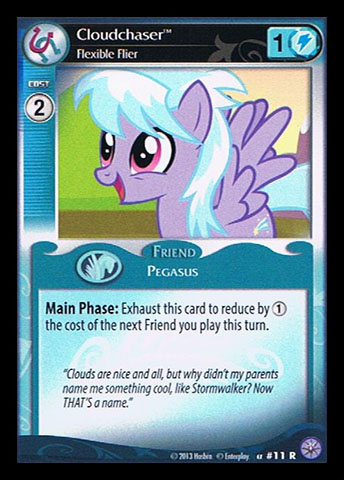
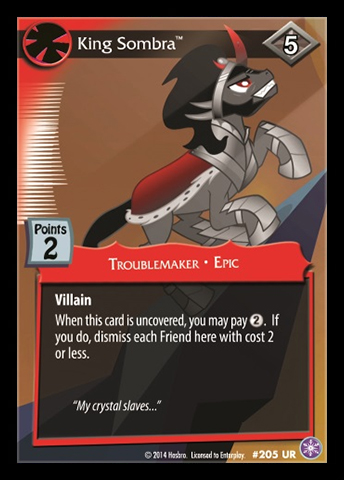
1. Bronies Don't Care For A Destructive Game
First, read this article at Channel Fireball that outlines the principles of creative and destructive elements in games. This is a good base for the rest of the discussion here.
Many games involve tension between creative and destructive elements. Creative elements add to the game state: bringing cards into play, drawing cards, creating combos and synergy. Destructive elements subtract from the game state: removal, discard, lockout. Cloudchaser here is creative: she lets you get more friends, more ponies, more friendship. Sombra is of course destructive, killing off any unfortunate ponies near him.
MLP CCG deliberately had low levels of destructive elements in the beginning. Premiere had all of three cards that would remove friends from the playfield. Canterlot Nights added only a bit more. But then Crystal Games and Discord both exploded with destructive elements. Play a pony, kill a pony. Start a faceoff, kill a pony. Have a party, kill all the ponies. Dare to do something as heinous as having more power than cost, kill a pony for free. Play a problem, kill all the ponies. Solve a problem, kill all the ponies.
Kill kill kill. This isn't the Crystal Games, it's the Hunger Games. Why is all this killing in My Little Pony? Why would you expect bronies to want this?
Destructive elements are a natural part of games like Magic the Gathering. Creatures exist to die. Attacking and blocking kills them as a basic part of the game mechanics, and it's normal for a game to see board-sweeping effects kill off a bunch of creatures to then rebuild. Discard and counterspells are also a natural part of a magical war between powerful mages fighting over their spells. Nobody sheds a tear when a dragon hits the graveyard.
But destructive elements are not a natural part of My Little Pony and the brony community. We are well known as the most creative and productive fandom on the internet, making amazing art and media with our favorite pony friends. We are very expressive. Deckbuilding is very much an expressive vehicle, so a CCG would seem to naturally fit for the brony audience. We can express ourselves with decks designed to play cool ponies doing cool things.
What we don't do is express ourselves by tearing down somepony else. We don't see the appeal in destruction. A game should be about having fun, not about oppressing our opponents out of their opportunity to have fun. This held all the way up to the highest level of MLP CCG competition: at the North American continental championship, about 75% of the deck entries were aggro. We're not interested in the griefer crap. In Rainbow Dash's own words from Wonderbolts Academy: Being the best should never come at the expense of your fellow ponies. Yet that's the way the CCG has been designed to operate.
Put another way: I love Cloudchaser too much to put her out there to get killed by King Sombra. If you understand this principle, you will understand why I and so many other bronies have rejected this game.
1A. Too Much Negativity
By destructive elements, I mean more than just direct removal and killing. The game has exploded with cards that have a negative impact on the game state in many ways.
Can't have abilities, can't have abilities, can't have abilities, can't have abilities. Can't score points, can't score points, can't score points, can't confront, can't confront. Can't play cards, can't draw cards, can't ready, can't exhaust, can't move.
Can't, can't, can't. Can't do the things that your ponies are supposed to do. Can't do the very premise of the game. Can't use your cards. Can't have fun. Unless your idea of fun is making sure your opponent can't have any.
I understand why this material exists from a designer's standpoint. It's a belated attempt to make up for problematic design and pacing in the game from the beginning. It was never expected to have those 11-point double faceoffs that leap from turn four to game over in seconds, that's not healthy. The game engine doesn't support generalized reactive elements like counterspells. So these preemptive "can't" effects are how to answer these problematic situations and cards. Except it just makes the opposing side miserable as they stare at all these "can't" cards that are ruining their day and their ponies. "If you can't beat them, join them": the right answer competitively is to join in and play "can't" cards of your own. But the right answer socially is to go find a better game that doesn't need all this negativity to make up for its own mistakes.
I play ponies for happiness and friendship, not negativity and oppression. I can't be alone.
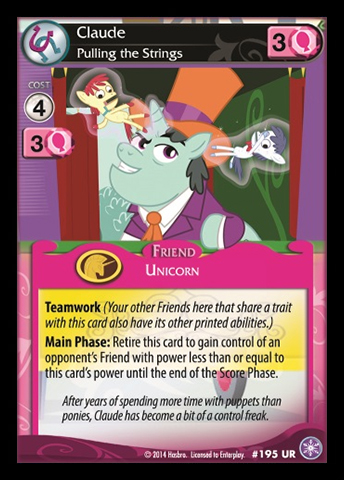
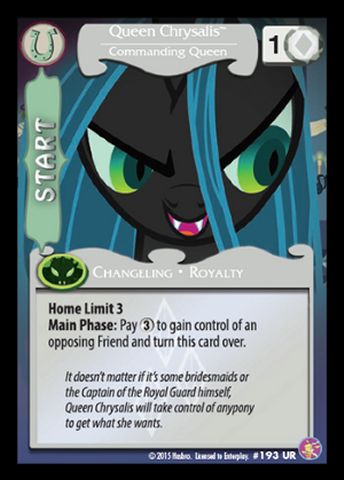
2. There Is No Message Of Friendship
With the release of Crystal Games, there was a post on Equestria Daily with development team members discussing their favorite cards. This included Claude, Pulling the Strings. This card lets you both steal and kill off opposing friends. "Really, really mean" as that post directly says.
Hello? What the buck?
What in the world is "really, really mean" doing in FRIENDSHIP IS MAGIC, let alone being called out as a favorite of the development team. This card more than any other single offender drove me and my entire playgroup right out of the game. Holy crap do you not get what makes Friendship Is Magic special. If you want Really Really Mean in your game, buck off and take it the hell out of My Little Pony. Go put this crap in Yu-gi-oh where it belongs.
And the Chrysalis mane from Absolute Discord is just about the most poisonous card imaginable for My Little Pony fans. Why would anyone ever want to play a game involving this at all? Sitting there right from turn one is a giant sign saying "I AM GOING TO STEAL YOUR FAVORITE PONY." Who would even play such a game? Who is excited by foreknowledge that your best pony friend is guaranteed to brutally betray you? Bronies are simply not going to play that. We'll go play Shipfic instead.
I got so invested in this game in the first place because it was a respite from all the nasty stuff in Magic and Yu-gi-oh and other games. The Premiere and Canterlot Nights sets deliberately had low levels of removal and disruption and no theft at all, exactly as My Little Pony should be. Why did I always play the pegasus decks in the competitive events? Because these are the expression of teamwork and friendship in the game, putting together a pegasus racing team with Rainbow Dash and Cloudchaser and Wild Fire and Bulk and the others. But these were barely playable against the control decks of the time, and now are hopelessly worthless against the ever more powerful griefing mechanics coming to ruin your day.
There is no message of friendship in the game. You don't win through ponies and friendship, you win by most brutally stealing and oppressing your opponent's. And that's not what Friendship is Magic fandom is about.
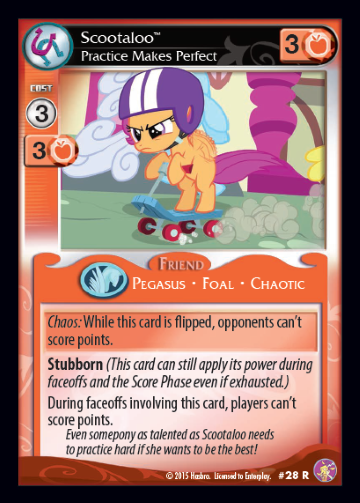
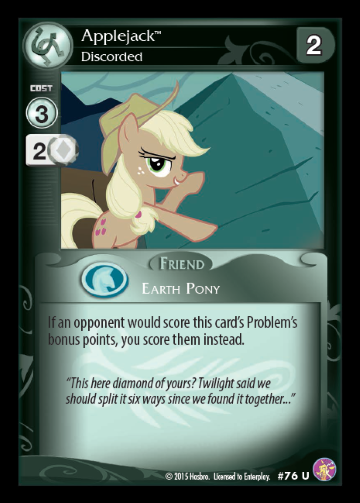
3. The Developers Write For Themselves, Not Their Audience
For seasoned veterans of game playing and development, everything I've written above is normal. One principle of design in games like Magic is that fun comes from interactivity between opposing players. Game plans run into each other - no plan survives contact with the enemy - and the fun is in seeing how they bounce off each other and what comes out on top.
Take these two cards from Absolute Discord as examples, cards that prevent or steal points. To game veterans, these create interesting situations, inverting the normal flow of the game. They create new hazards to navigate around. To a game developer, this is great material.
But to bronies playing the game, this is another mistake with no appeal. We will hate doing all the work on a problem to then see our hard-earned points go unscored or stolen. We will not take a thrill in doing that to our opponent. This isn't fun or crazy or entertaining. It's depressing. Sure, the hardcore competitive group of about twelve people on Reddit will eat up these new ways to screw their opponents... and you will never hear from the silent majority that simply stops playing and buying the game thanks to junk like this.
What's gone wrong here is that the developers are writing for themselves, to satisfy themselves as gaming veterans, and not for the bronies. No less a luminary than Magic the Gathering Head Designer Mark Rosewater says this. "My biggest mistake in Magic was designing to demonstrate what I could do rather than make a set that would be enjoyable to the audience."
And that's what we've got, sets that are written to show off what the developers can do, not to be enjoyable to the audience. Participation has crashed ever since Crystal Games, and Discord is showing more of the same. Because the game that exists is not the game that the audience wants. The game that exists is a mechanical rehash of concepts from Magic and Star Wars and Pokemon with a thin layer of pony faces pasted on. The game we want would uphold the joy of ponies and the ethos of friendship and the fandom, but those values are not expressed in this game and its cards.
If we wanted a game with the killing and disruption and griefing of Magic, we'd just be playing Magic. MLP needed to aim for a niche apart from MTG and failed. The developers are writing for their own competitive aesthetic, and to be fair, producing a decently competitive game in doing so. But there's no reason to partake in a merely decent game over the much more highly refined and professional game of MTG itself.
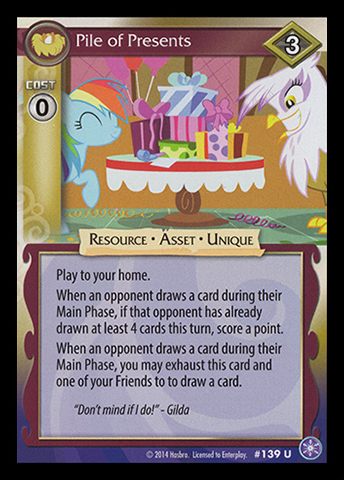
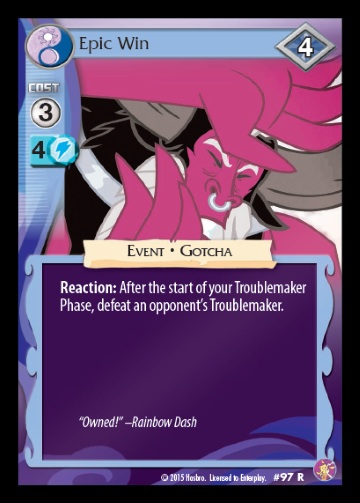
4. Focus Keeps Moving Away From Ponies
Here's another aspect that fails to appeal to pony fans. The focus of the game keeps moving away from ponies.
The premise of the game is ponies confronting problems. Troublemakers, of course, stop ponies from confronting problems. Then you have cards like Snips & Snails Problem Solvers that stop troublemakers from stopping ponies from confronting problems. Then you have cards like Plum Tuckered Out that stop S&S from stopping troublemakers from stopping ponies from confronting problems.
Or, Canterlot Nights had the well-known combo deck One Pace, which would circumvent the entire idea of ponies solving problems by playing an endless series of point-scoring cards. Enterplay's answer was Pile of Presents to put a stop to the card-drawing. The combo decks then responded with Seabreeze's Flower as resource removal to counteract Pile.
What's wrong with this picture?
To a seasoned game designer, nothing. It's a series of answers and counter-answers, the fuel that drives a metagame, compelling stuff.
But to someone who is a brony first and gamer second, everything. We're now three levels away from actual ponies solving actual problems. You have to get through three or more levels of answers and counter-answers before you can even do what the game is supposed to do.
Skilled competitive gameplay fails to resemble the very premise that the game is supposed to be about. Try explaining to a new player what tournament decks are good, to get them interested in developing their skills. You can't, because they lose interest when they realize how bastardized the gameplay becomes away from ponies solving problems. Another combo deck involves using Rock Farm for forced draw to combo with Pile of Presents for forced points, another way to win without ponies.
There is indeed an audience that likes this. Some folks and designers find that the most fun thing to do with rules is to break them. But this is no more than a noisy minority online. The people on the ground, the bronies who meet up at local groups and conventions, are the ones turned off wholesale as they realize how little the game is about ponies.
So it goes with Epic Win which shows more of the same in Absolute Discord. Yes, the game needs answers to oppressive troublemakers, and this is an effective one... but does it in absolutely the wrong way. Now your ponies aren't even relevant at all! Point and click, remove that villain, who needs ponies!
The more that ponies are pulled out of this game, the more bronies will pull away from it. Once again, this is a product of designers designing to their own mechanical interests and perceived needs, while forgetting that what underpins the audience is a love of the ponies. So where are the bronies? Over at the other table playing the pony card game that's actually about ponies.
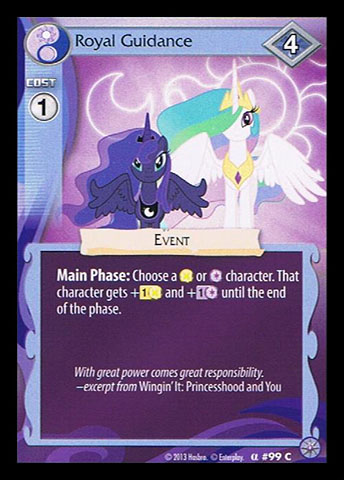
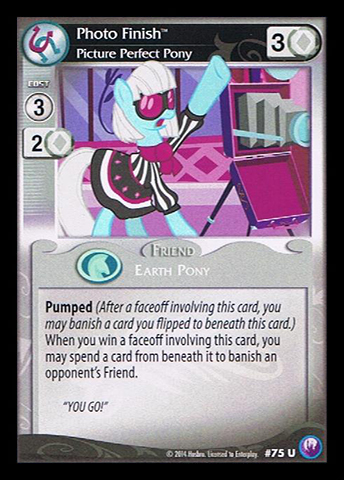
5. Inelegant Subversive Complexity
This concern rings differently than the above points, since it's not about new development, but problems that have plagued the game since the beginning. What follows is not so much why players are dropping the game, but why they never adopted it in the first place beyond a starter deck.
I've taught MLP CCG to something like forty people, between local meetups and conventions. I've seen players get wrong almost every rule and interaction imaginable. Some particular mistakes occur over and over again. Is this the players' fault for not reading the cards or grasping the comprehensive rules, as Enterplay seems to want to think? No, no, no.
Once again, Mark Rosewater calls this right. "If a large number of players keep making the same mistake, it's not their fault, it's the game designer's fault." "Players jump to conclusions without reading a lot. A lot!"
Take the color fixer events, like Royal Guidance above. Every single player I've ever taught thinks these events add power for confronting problems. They've just been fresh off the rules explanation about how power and problems work, and oh hey this card adds power, great! Except that it lasts until the end of the main phase so it doesn't do what they think.
Another prime example is Pumped cards and in particular Photo Finish. Everyone who reads Photo Finish or Fancy Pants thinks that you pump the card then immediately spend it for the effect. The card is written in that order so of course that's how it works, right? Except no, it subverts your expectation with that tiny but huge technical difference between "After a faceoff" and "When you win a faceoff". Oh, you haven't read the Comprehensive Rules to understand the twelve steps of faceoff timing in excruciating detail?
And there is the horrible distinction between Mane Characters and Friends. Everyone who picks up a Rarity starter deck starts by putting a Marvelous Chapeau on her. Rarity is all about fashion and hats, so hey cool, I get to dress her up! Except no. Read the card again, it says "Friend", your Rarity isn't a friend, you can't do that. Or anything else that seems like it should work with your mane but doesn't.
One more: the wording of troublemaker cards, that 'talk' to their owner despite facing and interacting with the opponent. Everyone thinks Diamond Dog pays out the actions to the player who beats him, since of course that's the logic, you beat a bad guy and you get a reward. But no. Diamond Dog defies all logic in that his controller gets the actions when he loses a fight. Yes, the card works correctly according to its wording, since cards always refer to their controller unless specifying otherwise. But man does it not work correctly according to players' expectations.
The net effect of all these cases is to turn off and discourage players with feelings of being tricked and subverted. Just as the new player figures out something cool to do, the teacher has to shoot them down and tell them, no, you played it wrong. This is not the player's fault, it is the fault of a game designed with intricate inelegant technical complexity for an audience for whom that is not natural.
We'll close this section with a lightning round on misunderstood distinctions. Playing vs moving characters: everyone thinks Solar Wind triggers on moving or that Wild Fire can 'move' a card from hand. Exhaust vs frighten: two entirely different but similar-looking ways of temporarily disabling a character out of play. Single faceoff vs double faceoff: sometimes it matters if the other guy is confronting but sometimes we continue to a faceoff regardless. Problem faceoff vs troublemaker faceoff: are we using the power number on the problem or on the troublemaker and wait your friends are involved but mine aren't man these rules don't make any sense. Troublemaker phase vs main phase: new players often think they're playing out ponies to fight a troublemaker right away instead of after a whole turn cycle. Face-up vs face-down troublemakers: every Rainbow Dash starter deck player thinks she flips with a face-down TM. "Does this stack?" Uh, some of the words like Random and Inspired do, some like Studious don't, yeah you just have to memorize them.
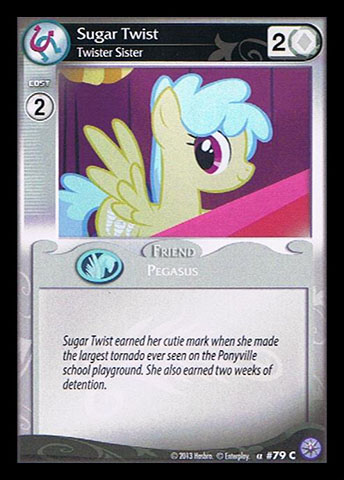
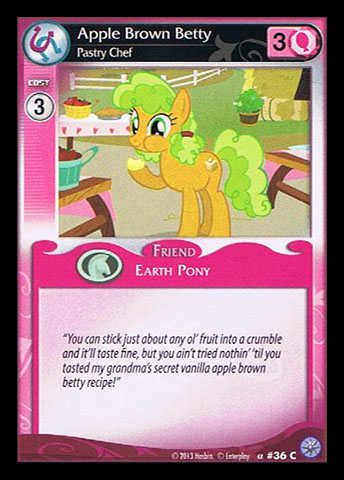
6. Inaccessible Learning Curve
Besides understanding the tricky cards and the structure of the rules, understanding the structure of deckbuilding is also a substantial task and headache. To construct even a functional deck requires understanding of so many principles and subsystems. I don't mean a powerful or competitive deck, just one that can even work to play its cards.
How does a newcomer start to develop a deck in games like Magic or Pokemon? They open a few booster packs and throw in whatever cards in their colors look interesting. We've all seen MTG newbies play their 100 card piles. They don't work well, but at least they function and the player can have some fun. But this doesn't work for MLP and let's examine why.
The biggest problem is secondary color entry. MLP decks must include at least two colors, thanks to the problem requirements. (This alone adds a mandatory level of complexity over the many monocolor Magic starting products.) To enter a color other than your mane character, you need some of these friends that provide a secondary color with no requirement in it. It is not at all obvious that these friends actually function more like basic land. With my local playgroup, exactly one player besides me out of a dozen or so got this correct when we started up back in Premiere. Everyone complained about color lock until I took a look at their decks and stuffed in all the missing copies of Sugar Twist and Apple Brown Betty.
And that's why the newbie "throw in everything" approach doesn't work for MLP and why new players can't start to climb the learning curve. You cannot functionally play a deck much bigger than 45 cards, since there doesn't exist enough secondary color entry. You need close to 20% of your deck space devoted to color entry in order to reliably draw it, but this is not at all obvious. To play an MTG or Pokemon deck, you throw in 40% land or energy split between the colors and you're fine. For MLP, a newbie buying packs doesn't even know what entry friends exist in their colors, never mind possessing enough of them even for a normal size deck.
From a designer's standpoint, it's a neat and clever mechanic to roll the mana ramp subsystem in with the character subsystem. Instead of boring lands, you curve up with active characters, that's more interesting. But from a user's standpoint, this conflation of subsystems is unintuitive and inaccessible.
More obstacles to learn deck construction come from the mane character. You also have to understand that the starter decks with two mane characters are not how the game is actually played. You only use one and need to design around her. That is not at all obvious until you're told by an experienced hand. So you don't need entry for the mane character's color, but you do need cards of 1 color requirement. Unless your mane happens to be one that can ignore that and jump right to 3.
Then you need the tools that will meet your mane character's boost condition. I've seen Fluttershy decks that overlooked including any critters, and of course the Rarity Canterlot Nights deck comes with a mere four cards that can boost her. Or your boost condition might be screwed up by needing entry to reach that boost condition itself, my go-to example being Twilight Sparkle Gala Greeter trying to play Back Where You Began.
And then there's the problem deck. Newbies have no idea what to do with that. Problems aren't interesting, we're not here for that junk, we're here for ponies. Several times at meetups I've had to construct and lend a problem deck to a player who overlooked making one. Or else they go too far, getting caught up in reading the abilities on problems and trying to unlock and trigger those effects, many of which hardly do anything. Problems are really all about matching their numbers to your characters' numbers, but again that's not intuitive for new players.
Finally, card value in MLP is difficult to perceive. What's good in Magic or Pokemon is pretty obvious: get a big monster and smash face until something dies. What's good in MLP is considerably less intuitive. Fatties don't do nearly as much in a game where a big number doesn't directly advance towards a win condition but rather can only go towards the available problems. The best cards in Canterlot Nights to improve a starter deck are the 1:2 cost:power friends, but this is not at all intuitive until I stuff them in someone's deck and they play five games before realizing they're solving that many more problems.
So that's about six principles and subsystems you need to understand to even begin to develop and improve your MLP deck. No wonder so many players never made it beyond a theme deck and small handful of boosters.
And even when you have a functional deck, there are too many cards in the MLP starters that are narrow to the point of uselessness. The worst is Hard Hat, which is literally nonfunctional in its starter which has no way to exhaust anything. Problems are also terrible in this area, with the worst example being It's a Twister, for which not a single card in Premiere could take advantage of readying at home outside of the main phase.
But it's not at all obvious to identify and remove cards like these from the starter decks. New players can't distinguish what subsystems and conditions are important and what should be junked. Players keep cards like Ponyville Express and lose games while not realizing how narrow and useless it is.
How do you make this learning curve of so many subsystems and concerns more accessible? You do it by not having so excessively many subsystems in the first place. Magic the Gathering has had decades of determining how to do this right. It's important that monocolor decks function, and in fact most Magic starter products are monocolor for the sake of simplicity. You can throw in just about any on-color card into an MTG starter and play it just fine. You can't mistakenly remove your mane character's boost condition from an MTG deck. MTG has a far smoother entry experience, and that's why players continue to pick that up instead of MLP.
This leads into my final point:
7. Kitchen-Sink Overload
I won't dwell too much on this, as it's been covered well online in other places.
MLP CCG is widely mocked online for the complexity and difficulty of learning its rules and cards. What other game of any type needs a ten-point article on misunderstood rules within a month of release?
From the standpoint of a designer, MLP looks great, pulling in elements from many other games. We've got the color pie of Magic the Gathering, a faceoff mechanic descended from the Star Wars CCG, a home bench and characters that evolve to a more powerful form as Pokemon players will know well. We've got lots of different game aspects to manage: you solve problems, and fight bad guys, while managing your home limit and action total and color availability and mane character trying to boost.
All this great gaming stuff should add up to a great game, right? No. It's kitchen-sink overcomplexity and less than the sum of its parts. It's an engaging experience for the small population of experienced gamers used to managing a dozen subsystems at once... and it dramatically fails anyone trying to pick up and understand all these rules from a starter deck.
Design is More About Finding Elegance than Novelty.
What is the most important thing a first experience with a game must do for a player? It has to get them to want to play again. MLP CCG fails on this. Getting through the first game isn't an eager moment of anticipating more. It's a sigh of relief as the brain-burning technical complexity where we keep talking about mechanics and numbers and boring rules instead of ponies is finally over.
MLP CCG could have been a new anchoring experience of the fandom. It could have become the default social activity for bronies of all walks at all types of gatherings. Hey, pull out your pony deck and let's have fun. But it came out too inaccessible and destructive and unponylike to attract any more than a tiny percentage of its should-be audience.
The End
I could say more, but this writeup is long enough. I needed to write this for the catharsis of letting go from the game. See you at some other gaming table, probably Shipfic. In Twilight's own words from Rainbow Rocks, it doesn't matter what we play, as long as we play it together.
- vikingerik
I'm returning to this page for some more perspective after Gen Con and Bronycon 2015.
The ultimate thesis of my original post here is that MLP CCG is not a fun game. It does indeed attract a certain crowd for competitive tournament play. There are layers of answers and counter-answers and back-and-forth interplay and metagame considerations. It's a deep game... that just isn't any fun to actually play. It's as much fun as doing your math homework.
MLP CCG fails the brony audience, as I wrote originally. You're not solving problems with ponies, or if you are, you're taking a naively dumb approach. If you try, you'll get bitchslapped by villains or you'll sit there not playing the game while a combo deck ignores you. We saw this bigtime in the metagame composition at 2015 Nationals: everything was pink combo or orange control decks. Ponies solving problems, the very premise of the game, were nowhere to be found.
For a competitive gamer audience who ignores the pony flavor in search of winning, this could be a worthwhile game. Some folks like math homework, after all. But there's still the question, why play an overdesigned clunky copy of Magic the Gathering over just playing MTG itself? Why play a game that's gone a whole year without being able to change the same two stale metagame decks? There's plenty of better games to be found, why spend time and treasure on this one?
But what brought this post to mind was the buzz all around Bronycon. There was indeed a huge audience anticipating a pony card game. There were lines dozens of people deep in the vendor hall to buy it. Games broke out on the floor all over the convention center, while waiting in lines or just hanging out with friends. The introductory events in the game room drew dozens of new fans. The design-a-card panel drew hundreds. There is indeed a wonderfully successful and fun card game about our ponies.
And it isn't the Equestrian Odysseys block.
It's Twilight Sparkle's Secret Shipfic Folder.
TSSSF is succeeding because it does what the CCG doesn't: provide an accessible, fun, entertaining game.
Obviously there are great differences between the genres of a deckbuilding CCG and a prepackaged game. You can't play the CCG if you haven't bought and prepared a deck ahead of time, while anyone can jump in and start playing from one set of TSSSF. A CCG is naturally exclusionary. This is not a knock on the CCG, it comes with the territory... but it is relevant that being exclusionary does not mesh with the brony mindset of friendship being magic.
But even aside from the genre, in the actual gameplay mechanics, TSSSF blows away the CCG in audience reception and mindshare.
It's so much more accessible. Put out Twilight, draw 7 cards and three goals, and start playing ponies and ships in a grid. You don't need a fifteen minute explanation about colors and power requirements and action schedules and six different turn phases and six different card types and mulligans and all that junk. You're playing Shipfic within three minutes of seeing it for the first time.
And you're playing it the RIGHT way, right away. See those Goals? Just match up to what they say and you score points. The Shipfic game adheres to its own premise. Scoring Goals is your objective and is the only way you win. You don't ignore the goals to go farm villains instead. You don't get locked out of being able to play the game. You don't get an event thrown at you to miserably block or steal your goal. The game is properly centered around its own goals rather than marginalizing them.
Aren't Goals just like Problems? No, they're just like the good parts of problems. They don't have extra lines of text that half the time mean nothing and half the time screw somebody over. They don't inflict different requirements on each player. And they don't have an extra clunky layer of bonus points that sometimes you score the number and sometimes you score only 1 instead and sometimes you go have a faceoff. The Goals just do and score exactly what they say they do. And that simplicity seriously matters towards the game's fun factor.
The subversive topic material helps too. Shipfic is always a blast no matter how the game goes. It's always hilariously entertaining to ship Rainbow Dash with three other females, or Granny Smith with anypony, or whatever other twisted combinations come up. Shipfic is viscerally FUN. Over in the CCG, nobody really cares about whatever fashion emergency or apple problem you're solving, if you even can solve anything through the brigade of villains. This is the principle the CCG has sorely lacked, to keep the gameplay fun and vivacious and visceral.
Look at the CCG room at any of the pony conventions. What you'll see is players hunched over in dry tense cold combat. Now look at a Shipfic table. You'll see everyone cackling out in glee and enjoying themselves warmly. Which one of these aligns with Friendship is Magic?
In short, TSSSF does right so much of what the CCG does wrong, and so it and its enjoyable experiences have well earned their place in brony mindshare ahead of the CCG.
- vikingerik